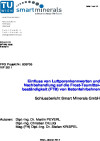FTB-Concrete Surface – Influence of air void characteristics and aftertreatment for frost and de-icing chemical resistance of concrete carriage-ways
Short Description
Starting point / motivation
During their life span concrete pavements are exposed to high stress levels caused by traffic and environmental conditions, in particular the freeze-thaw agents. The regulations and standards currently valid define requirements for binder content, w/c-value and air void system that generally meet these requirements. If one or more values are below the respective limits, the resistance against environmental impact is not guaranteed to the same extent.
In pavement construction, very high requirements for the resistance of surfaces against external influences particularly freeze-thaw resistance are demanded and have to be maintained throughout the entire life span. Concrete with a persistently high quality (required binder content and w/c-value as well as an adequate air void system in hardened concrete) and a good curing of the placed concrete pavement are fundamental.
Due to different influencing factors during the construction process but also due to external influences through weather conditions, the demanded requirements cannot always be met unerringly.
Contents and goals
Due to this fact, the aim of the research programme was to clarify, in which extent this insufficient quality of concrete has an impact on the freeze-thaw resistance of the concrete over its life span.
Methods
The interrelations between air void distributions, w/c-value, porosity of the binder stone and curing in relation to the occurrences of erosion due to freeze-thaw strain were analysed by means of a laboratory test was made. Based on the results, damaged sections of real motorways and highways were evaluated with the same evaluation methods. Building on all results collected, a matrix was established on the interrelations between the quality of concrete and possible structural damages due to freeze.
Results and Conclusions
Both, laboratory-results and field test have shown that the most appropriate way to determine a sufficient frost- and thaw resistance of concrete carriage-ways is the use of air void characteristics and its regular monitoring. It was also demonstrated that the subsequent verification of the preparation water content on fixed concrete is an effective means of ensuring a sufficient quality of concrete cover.
In the context of drawing together the results, a proposition for possible changes to the currently valid guidelines were elaborated.
Publications
FTB-Concrete Surface – Influence of air void characteristics and aftertreatment for frost and de-icing chemical resistance of concrete carriage-ways

This research project analyzed how a noncompliance with requirements or has a negative effect on the freeze-thaw resistance of concrete pavements.
Dipl.-Ing. Dr. Martin Peyerl, Dipl.-Ing. Christian Dillig, Mag.(FH) Dipl.-Ing. Dr. Stefan Krispel
Publisher: BMVIT
German, 151 Seiten
Publication Downloads
Project Partners
Project management
Dr. Johannes Steigenberger, Association of the Austrian Cement Industry
Contact Address
Association of the Austrian Cement Industry
Dr. Johannes Steigenberger
Tel.: +43 (1) 714 66 81-0
E-mail: steigenberger@voezfi.at
